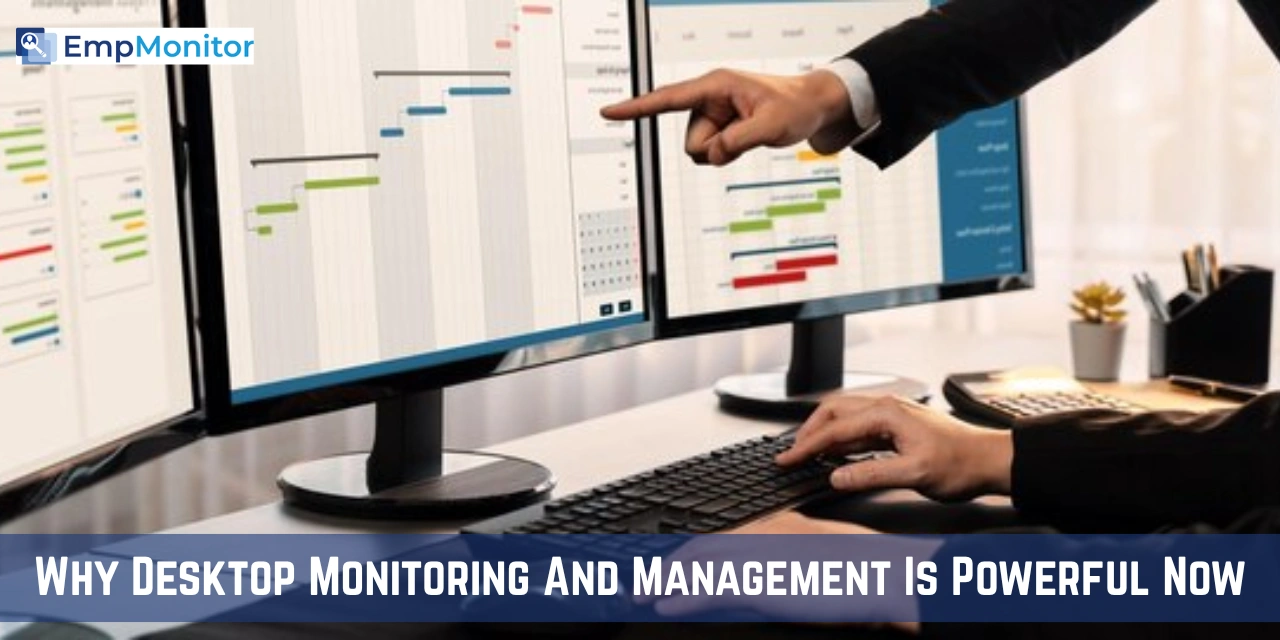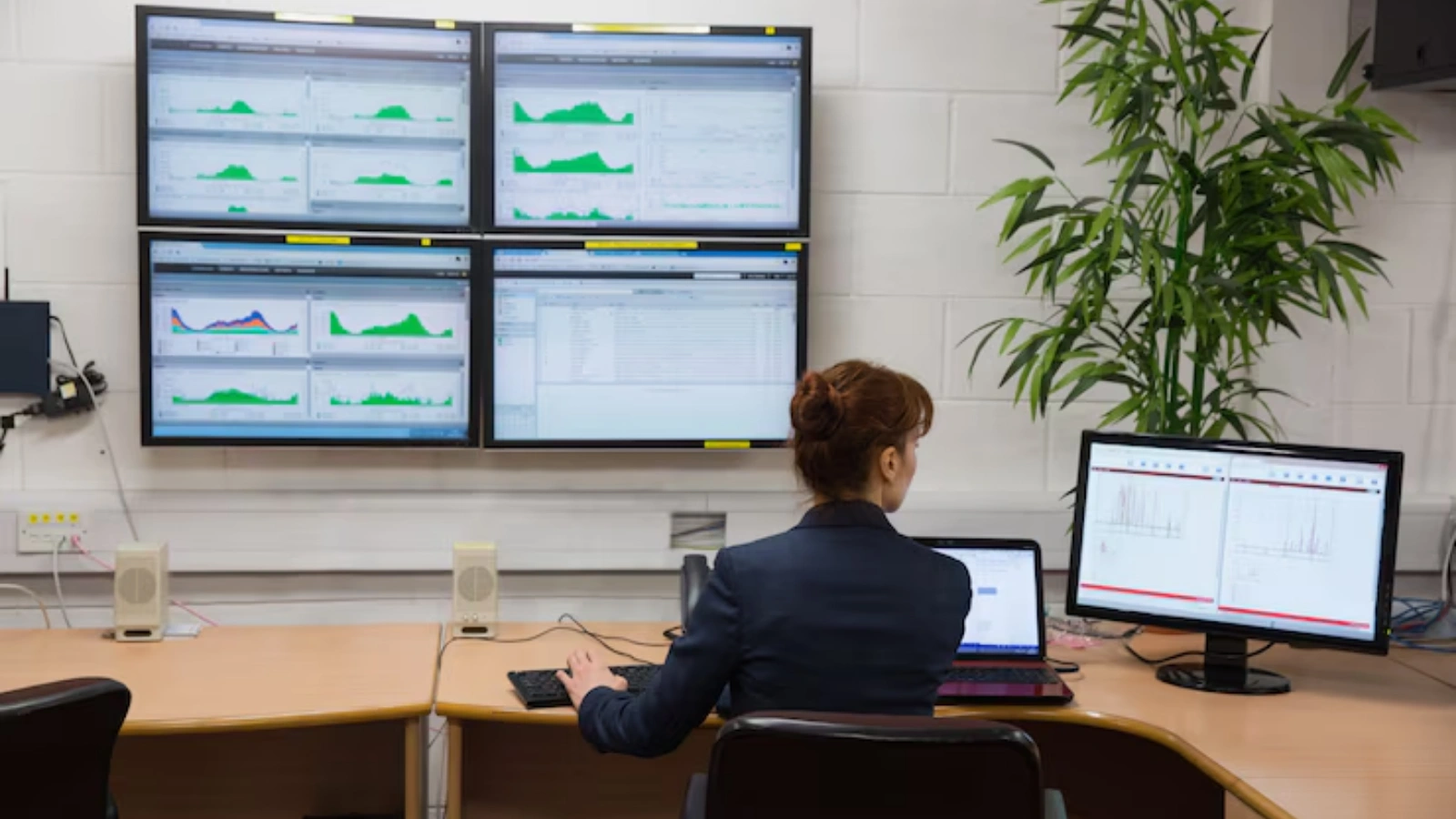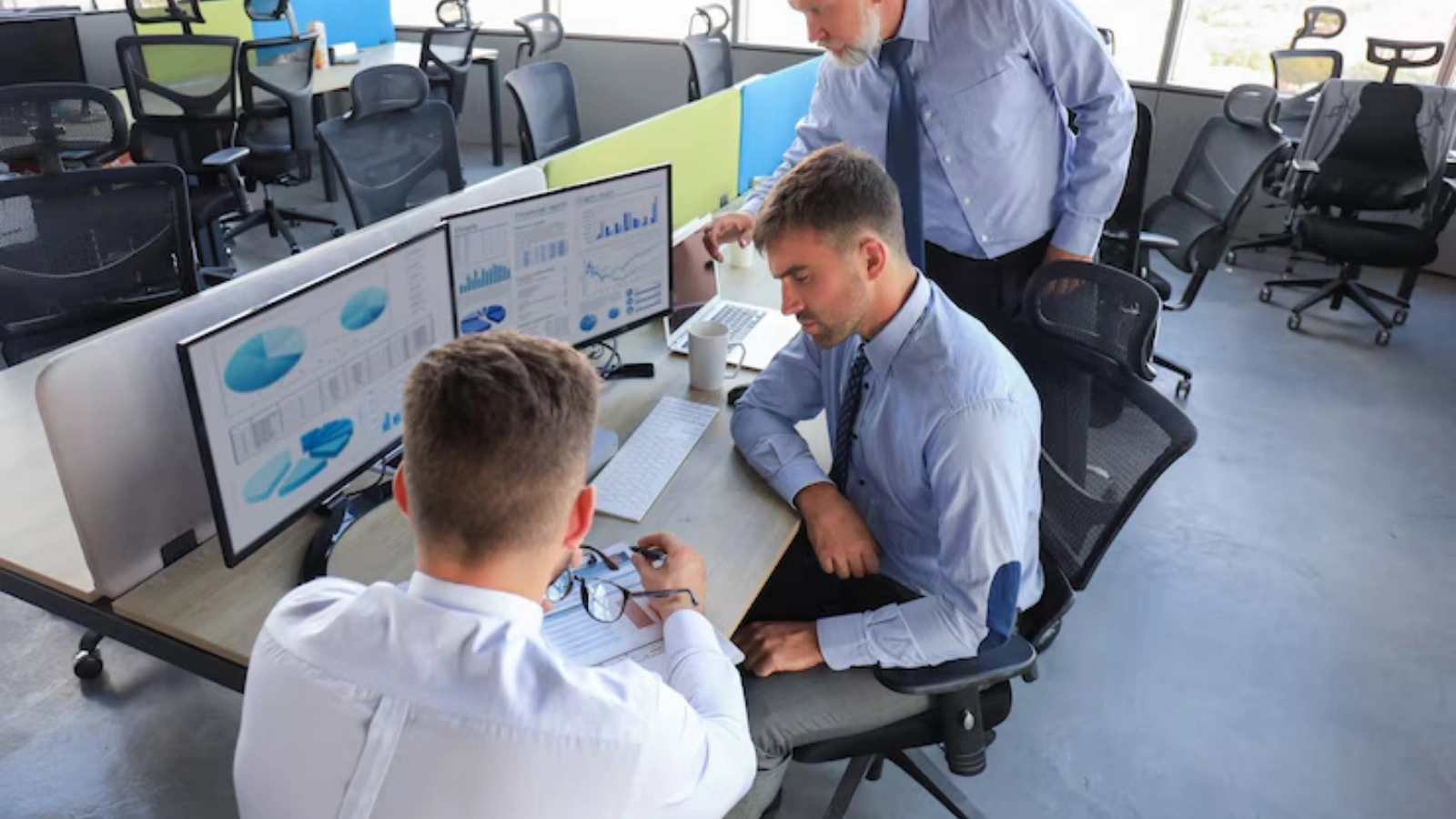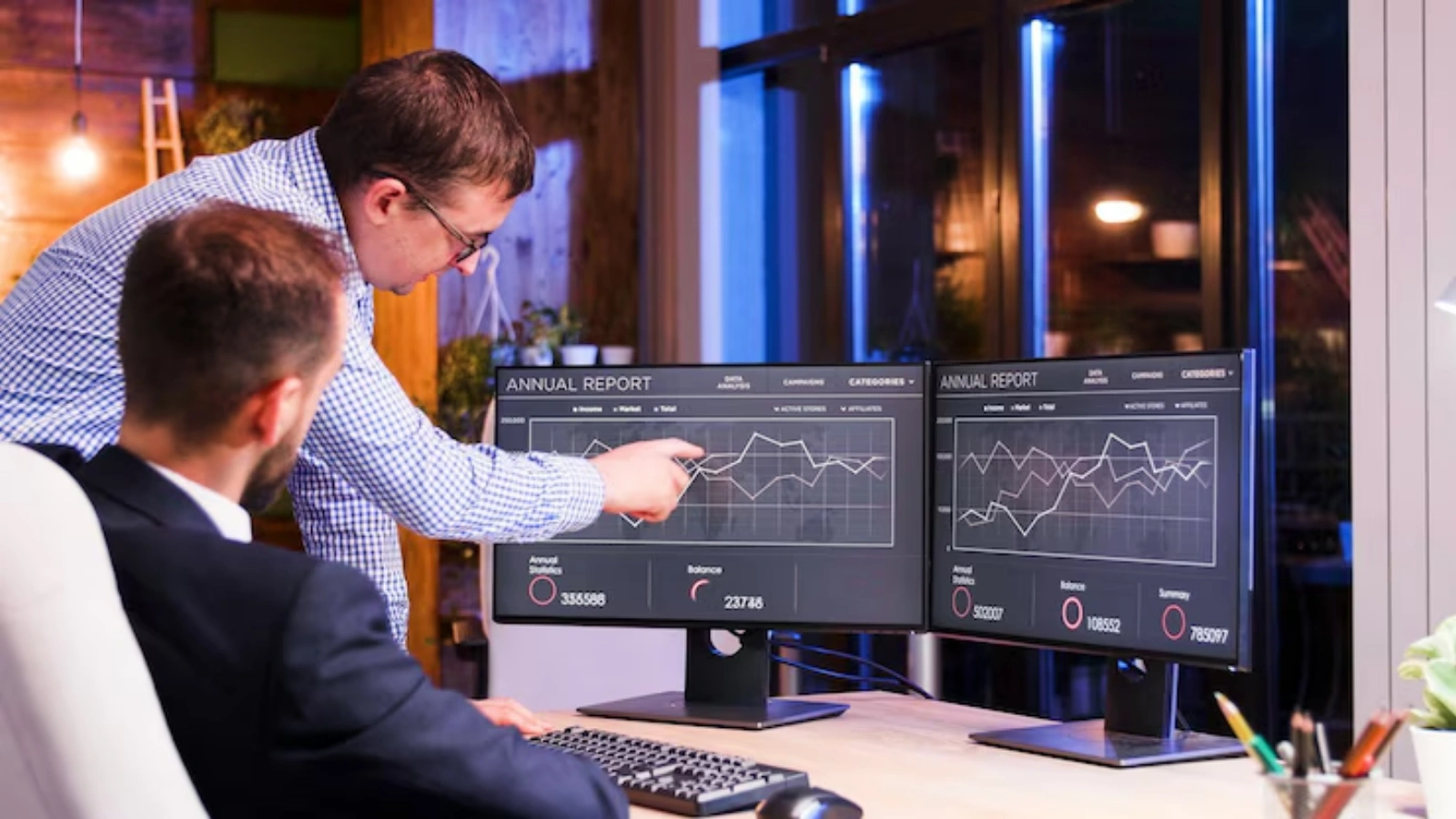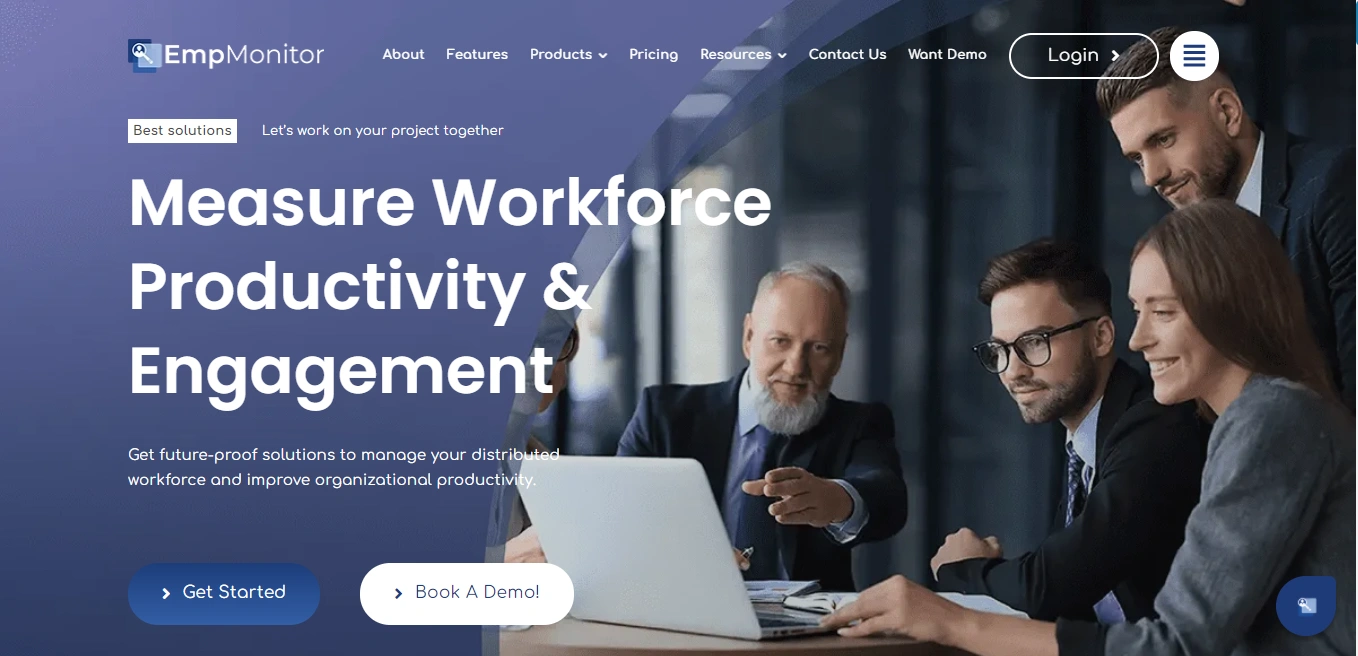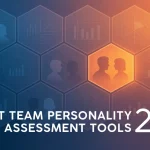Managing a team used to mean walking around the office, checking in, and solving problems face-to-face. But as work has moved across locations, devices, and time zones, keeping everything running smoothly has become a lot more complex. That’s where desktop monitoring and management become crucial.
This blog breaks down why this technology has become such a game-changer, helping businesses stay secure, productive, and organized without missing a beat.
Whether you’re running a small startup or overseeing a large team, knowing how desktop monitoring and management work can make all the difference.
Hit ‘Play’ Button & Tune Into The Blog!
What Is Desktop Monitoring And Management?
Desktop monitoring and management refers to the practice of overseeing user activity and maintaining system health across all desktop devices within an organization. Monitoring involves tracking user behaviors, application usage, browsing history, and overall productivity.
Management, on the other hand, includes tasks such as software updates, patch management, configuration settings, and asset tracking.
Together, they create a unified framework that provides IT teams and business leaders with full control over digital operations.
Unlike legacy systems, modern desktop management software offers real-time data, centralized dashboards, and seamless integrations, making it indispensable in today’s enterprise ecosystem.
Also Read:
Why More Businesses Are Turning To Desktop Monitoring In 2025?
So, what’s behind the growing popularity of desktop monitoring and management tools this year? The shift isn’t just about technology; it’s about how businesses are adapting to new work realities while striving to stay efficient, secure, and compliant.
1. The Remote Work Explosion:
Remote and hybrid work are no longer temporary fixes; they’re permanent fixtures. As a result, employers can no longer rely on physical presence to ensure productivity. Remote desktop monitoring software, when paired with a VPN for PC, offers real-time insights into employee activities, application usage, and system performance while ensuring secure access across distributed environments.
This enables managers to stay connected to their teams’ workflows without micromanaging or breaching trust.
2. Increased Cybersecurity Risks:
The more devices and networks involved in daily operations, the higher the risk. Cyberattacks are becoming more targeted and sophisticated, often exploiting remote endpoints.
Desktop monitoring and management software strengthens your security posture by flagging unusual behaviors, unauthorized access attempts, or risky software downloads before they escalate into threats.
3. Compliance and Legal Requirements:
Data privacy regulations are tightening worldwide. Whether it’s GDPR in Europe, HIPAA in healthcare, or PCI-DSS for financial transactions, businesses must maintain detailed records of system and user activity.
Monitoring software supports compliance by generating secure logs, offering audit trails, and enforcing access controls, helping you avoid costly penalties and legal issues.
4. Demand for Productivity Insights:
Beyond security and compliance, there’s a growing focus on performance optimization. Companies want to know: Are teams working efficiently? Are tools being used effectively? Workforce monitoring software helps answer these questions by identifying trends like frequent app-switching, idle time, or resource-heavy programs, providing data you can act on to improve output.
Key Features Of A Robust Desktop Monitoring And Management Solution
Modern tools offer a suite of features designed to meet the needs of fast-growing businesses.
Here are some must-have functionalities:
Real-Time Activity Monitoring:
Track user activity as it happens, including keystrokes, mouse movements, screen usage, and active/idle time. This allows managers to monitor workflow patterns, ensure employees stay on task, and quickly respond to anomalies.
Application and Website Tracking:
Monitor which apps and websites employees are using during work hours. Gain insights into productivity trends, block access to time-wasting or unauthorized platforms, and ensure compliance with company policies.
Automated Patch Management:
Keep all systems up-to-date with automatic installation of software patches and updates. This reduces the risk of vulnerabilities, minimizes manual IT workload, and ensures your systems stay secure and optimized.
Remote Device Control:
Access and manage desktops remotely to troubleshoot issues, install software, or configure settings, regardless of the employee’s location. It ensures uninterrupted support for remote and hybrid teams.
Smart Alerts and Anomaly Detection:
Receive instant notifications for unusual or suspicious activities, such as unauthorized software installation or data transfers. These proactive alerts help prevent security breaches and policy violations before they escalate.
Centralized Dashboards with Custom Reports:
Visualize data through intuitive dashboards and generate customized reports for productivity, usage trends, and security metrics. These insights empower leaders to make well-informed decisions and enhance operational efficiency
Role-Based Access Control:
Determine access to specific data or system functions according to an individual’s job role. This protects sensitive information, ensures accountability, and helps maintain structured visibility across teams.
These features are at the heart of the most reliable desktop monitoring and management solutions available today, ensuring your business remains secure, efficient, and performance-driven.
How Desktop Monitoring Software Can Help Your Business?
Modern desktop monitoring software offers a wide range of practical benefits for businesses.
Here’s how it can elevate your operations:
Boosts Employee Productivity:
Employee management software provides detailed insights into how employees spend their time, tracking activities across apps, websites, and tasks. This data helps managers identify patterns of distraction and underperformance without micromanaging. With visibility into work habits, businesses can implement strategies to enhance employee productivity, focus, and time management.
Enhances Security:
One of the core benefits of desktop monitoring is real-time detection of unauthorized access and high-risk behavior. It can alert IT teams to unusual file movements, external device usage, or suspicious downloads before damage is done. This proactive security layer is crucial for protecting sensitive business and customer data.
Supports Remote Management:
With remote and hybrid teams becoming the norm, managing systems across distributed environments can be challenging. Desktop monitoring and management software allows managers and IT admins to oversee system performance, software usage, and policy compliance from anywhere. It ensures business continuity and control regardless of employee location.
Reduces Operational Costs:
By analyzing how software and hardware resources are utilized, monitoring tools help eliminate inefficiencies and unnecessary expenses. Businesses can reassign unused licenses, prevent system overuse, and reduce manual oversight. Over time, these adjustments lower IT costs and boost operational efficiency.
Improves Compliance Readiness:
Regulations like GDPR, HIPAA, and PCI-DSS demand accurate documentation and monitoring of digital activities. Desktop monitoring software automatically generates logs and reports that serve as audit trails, making compliance audits smoother. This built-in compliance support minimizes legal risk and avoids penalties.
Provides Actionable Insights:
Beyond data collection, modern tools transform user activity into meaningful analytics. Managers can evaluate team performance, compare trends over time, and make informed decisions backed by real data. These insights aid in optimizing resource allocation, guiding training efforts, and enhancing performance management.
For businesses seeking an all-in-one solution, tools like EmpMonitor offer powerful capabilities to streamline employee desktop monitoring and management software, boost productivity, and ensure compliance.
What Makes EmpMonitor An Excellent Desktop Monitoring And Management Solution?
If you’re looking for a reliable way to monitor, manage, and elevate employee performance digitally, EmpMonitor offers a complete toolkit that delivers exceptional results:
Seamlessly Empower Employee Management Operations
EmpMonitor is designed to handle the complete spectrum of employee activities with smart tracking, reporting, and productivity-enhancing features.
Key Features That Set EmpMonitor Apart
Real-Time Activity Monitoring:
EmpMonitor provides a live dashboard that gives managers instant visibility into what employees are working on. Track active and idle time, websites visited, applications used, and overall behavior in real time to make timely decisions and interventions.
Automated Timesheets & Attendance Tracking:
Say goodbye to manual logging. EmpMonitor automatically captures clock-in/clock-out times, calculates total work hours, and even tracks break durations. This feature ensures accurate payroll and better scheduling efficiency.
Keystroke & Screenshot Logging:
Monitor every keystroke and capture periodic screenshots to maintain transparency and prevent data leaks. This level of visibility helps identify productivity bottlenecks and possible compliance violations.
Stealth Mode Monitoring:
EmpMonitor operates in a discreet, invisible mode without interrupting employee workflows. It silently collects productivity data in the background, allowing for unbiased and uninterrupted performance tracking.
Role-Based Access Control:
Ensure secure monitoring with tiered access levels. Team leaders, HR managers, and executives can each have customized visibility and permissions, ensuring only authorized personnel can access sensitive insights.
Data-Driven Productivity Reports:
Get detailed reports on individual and team performance, including productivity trends, task engagement, and behavioral analytics. These reports support informed decision-making and continuous improvement initiatives.
Whether you’re managing a remote team or optimizing in-office workflows, EmpMonitor is your all-in-one solution for smarter, more secure, and results-driven workforce management.
What’s The Difference Between Desktop Monitoring And Desktop Management?
It’s essential to understand the difference between these two vital components, as each serves a unique role in enhancing productivity, security, and IT efficiency.
Desktop Monitoring: Tracking User Behavior for Productivity and Compliance
Desktop monitoring is all about understanding how employees interact with their workstations. It tracks application usage, websites visited, keystroke patterns, time spent on tasks, and even captures periodic screenshots. This helps businesses identify productivity gaps, enforce acceptable use policies, and spot potential insider threats early. It’s especially valuable in remote and hybrid work environments where direct supervision isn’t feasible.
Desktop Management: Maintaining System Health and Performance
Desktop management focuses on the technical operations behind every computer or endpoint. It involves tasks such as operating system updates, software installations, patch management, device configuration, and hardware asset tracking. By automating and centralizing these IT responsibilities, businesses can reduce downtime, avoid security vulnerabilities, and ensure systems are always running efficiently. At the endpoint level, solutions like CleanMyMac Business support desktop management on macOS by scanning for system clutter and security risks that can affect performance, ensuring each device stays optimized and reliable.
At the endpoint level, solutions like CleanMyMac Business help manage macOS devices by scanning for system clutter and security risks that affect performance, ensuring each desktop stays optimized and reliable.
Why Combining Both Makes Sense
While each function can provide value on its own, integrating desktop monitoring with desktop management creates a holistic solution. Businesses gain full visibility into both human activity and machine performance. This dual approach not only improves productivity and compliance but also strengthens IT security and reduces system-related disruptions, delivering seamless digital operations across the board.
In an increasingly digital workplace, combining desktop monitoring and management is the key to achieving full control, productivity, and operational resilience.
Also Read:
Ultimate Guide To Enhance Organizational Performance In 2025
Who Needs Desktop Monitoring And Management?
While every industry can benefit, certain sectors have urgent needs that desktop monitoring and management can solve immediately.
IT and Software Companies:
Tech teams rely on desktop monitoring and management to track development sprints, monitor coding hours, and evaluate task completion. It helps managers identify bottlenecks and improve delivery timelines. Integrated time-tracking and reporting tools also support agile workflows and client transparency.
Finance and Banking:
In highly regulated sectors like finance, monitoring systems help detect unauthorized access, ensure secure handling of encrypted data, and support audit requirements. It provides a protective layer against insider threats. Real-time visibility helps maintain compliance with financial data protection laws like PCI-DSS.
Healthcare Organizations:
Patient confidentiality is non-negotiable in healthcare, and HIPAA compliance requires stringent access control and monitoring. Desktop monitoring and management ensure sensitive data is accessible only to authorized individuals. It logs all activity to create audit trails, helping avoid violations and fines.
Education and eLearning:
Schools and e-learning platforms use desktop monitoring to maintain student engagement and digital discipline. It helps educators track time spent on learning modules, monitor screen activity, and prevent misuse of learning tools. These insights enable more tailored and impactful teaching strategies.
Call Centers and BPOs:
Call centers operate in high-pressure environments that require maximum efficiency. Desktop monitoring and management provide insights into agent performance, application usage, and time spent on calls or CRM tools. Supervisors use this data for real-time feedback and to improve service quality.
What Are The Future Trends In Desktop Monitoring And Management?
- Predictive Analytics – AI will anticipate issues and inefficiencies before they impact performance.
- Unified Endpoint Management (UEM) – All devices will be managed through a single, integrated platform.
- AI-Driven Automation – Automation will handle patches, behavior tracking, and system optimization.
- Employee Wellness Insights – Monitoring tools may soon detect signs of burnout through user patterns.
These emerging trends signal that desktop monitoring and management is not just about oversight, but about smarter, proactive, and people-centric workplace transformation.
Conclusion
In 2025, desktop monitoring and management will stand at the heart of secure, high-performing digital workplaces. It’s no longer optional, it’s mission-critical.
From productivity boosts to cybersecurity improvements and legal compliance, this technology empowers businesses to move forward with confidence and clarity. Tools like EmpMonitor make this shift easier, offering intuitive dashboards, real-time monitoring, and actionable insights tailored for modern teams.
The time to act is now. Choose a solution that aligns with your growth goals and make desktop monitoring and management your next competitive advantage.
FAQs
1. Can desktop monitoring software work on both Windows and Mac systems?
Ans. Yes, most modern desktop monitoring tools are cross-platform and support both Windows and macOS, allowing businesses to manage mixed-device environments seamlessly.
2. How does desktop monitoring impact employee privacy?
Ans. Employee privacy can be maintained through clear policies, role-based access, and transparency. Monitoring tools should focus on productivity metrics, not personal data.
3. Is it possible to monitor desktops without disrupting workflow?
Ans.Absolutely. Most tools run in the background using stealth mode or low-resource configurations, ensuring continuous performance without affecting user experience.

